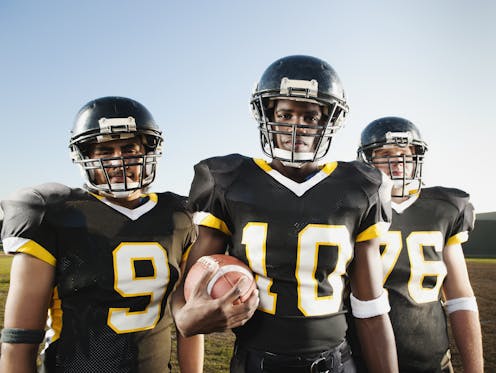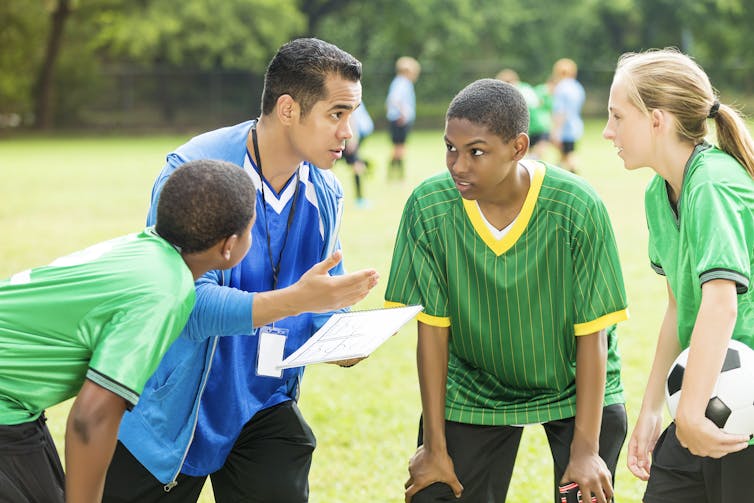Why safely reopening high school sports is going to be a lot harder than opening college and pro ball
- Written by Tamara Hew-Butler, Associate Professor of Exercise and Sports Science, Wayne State University
 Ongoing testing, say the authors, is critical to bringing back amateur sports.Getty Images / Erik Isakson
Ongoing testing, say the authors, is critical to bringing back amateur sports.Getty Images / Erik IsaksonAlong with the revival of professional sports comes the yearning for a return to amateur sports – high school, college and club. Governing officials are now offering guidance as to when and how to resume play.
However, lost in the current conversation is how schools and club sports with limited resources can safely reopen. As an exercise scientist who studies athlete health and an emergency medicine physician who leads Michigan’s COVID-19 mobile testing unit, we wish to empower athletes, coaches and parents by sharing information related to the risks of returning to play without COVID-19 testing. This includes blood tests to see if athletes have already had COVID-19 plus nasal swabs to test for the active SARS-CoV-2 virus.
Regular COVID-19 testing on all athletes may seem like overkill, but the current tally of 150 collegiate athletes, mostly football players, who have tested positive for COVID-19 grows longer by the day.
In sports – particularly contact sports – it’s critical to remove asymptomatic athletes – or those who do not show symptoms – before they infect others. This did not happen in South Korea, where one asymptomatic fitness instructor spread the virus to 112 people across 12 facilities, over 124 miles, and within 14 days. All this happened following a single vigorous four-hour dance session. The scariest point of this story is that these fitness instructors were spreading the virus before showing any symptoms.
 When amateur sport returns, you will likely see players and coaches wearing face coverings and observing social distancing as much as possible.Getty Images / SDI Productionds
When amateur sport returns, you will likely see players and coaches wearing face coverings and observing social distancing as much as possible.Getty Images / SDI ProductiondsRisks can be considerable
The risk for virus transmission from an undetected COVID-19-positive athlete is considerable, particularly those who compete without a face cover and in close proximity to others. Recent data suggests virus particles may travel through the air up to 27 feet, far beyond the six-foot recommendation for social distancing. Clouds of aerosolized virus can remain suspended for three hours. What’s more, during maximal intensity exercise, athletes breathe faster and more deeply – up to 20 times faster – than when resting comfortably. This increases both the amount and depth of inhaled and exhaled virus particles.
Athletes also spit and sweat, which further contaminates equipment, clothing and playing surfaces. Saliva has been shown to contain 92% of active SARS-CoV-2 particles, and sweat can transmit the virus through contamination with saliva or respiratory droplets. Along with all of this, vigorous training can decrease an athlete’s immune function which makes them more susceptible to infections.
The latest NCAA report confirms that roughly 8 million high school and 480,000 college athletes participate in sports every year. How many could become infected? One way to estimate is by examining current models. They suggest the virus could infect 20% of people, with a fatality rate of about 1%. Extrapolate those numbers, and the estimate is frightening: About 1.7 million involved in amateur sports in the U.S. – which does not include coaches, trainers, and parents – could become infected. About 16,000 could die.
We recognize that testing young athletes isn’t easy. It takes considerable time and expense. Our team – with approximately 80 researchers and four mobile COVID-19 units – can reliably test up to 500 people per day, at a cost of US$75 to $100 per person. And those at greatest risk – frontline workers, symptomatic individuals and people in poor communities, nursing homes and prisons – must be examined first. That means routine testing of amateur athletes before weekly competitions may become unsustainable.
 Those on the sidelines will also need to observe social distancing and wear face coverings.Getty Images / SDI Productions
Those on the sidelines will also need to observe social distancing and wear face coverings.Getty Images / SDI ProductionsOur five suggestions
The recent reopening of college football practice is already off to a rocky start, with LSU isolating 30 of 115 players after about two weeks of practice, while both Kansas State and the University of Houston have suspended voluntary practice due to COVID-19 outbreaks. In this evolving natural experiment, this small sample merely represents college football players returning to voluntary summer practice, where both COVID-19 cases and player-to-player contacts are expected to be low. Extrapolate that to about 8 million high school athletes competing in fall, with limited resources, and you can just imagine the consequences. Nevertheless, to keep high school, college and club sports participation safe, we do recommend the following:
Prior to each competition, all athletes and on-field coaches must be tested for the virus. Anyone who is COVID-19-positive will be removed from play and quarantined for 14 days, with contact tracing initiated. Game officials should verify that competitors have tested negative 24 hours prior to play. Pooled testing would save time and money. Should a pooled sample show a positive test, then all athletes would be screened.
Blood tests should be considered. Athletes who have COVID-19 and are IgG antibody-positive were exposed at least two to three weeks prior to testing; they are likely carrying a dead virus and not at risk of infecting others. Provided they are asymptomatic, they could return to sports earlier. But those with the IgM antibody probably have an acute infection; those athletes should not be on the field.
Those at the event, including athletes/competitors, should wear face coverings. The production of “athletic-friendly” face coverings, for use during vigorous training and competition, would reduce viral transmission.
Social distancing, hand-washing and frequent disinfection of equipment, surfaces and clothing should remain strictly enforced, especially on the sidelines.
Sharing food, fluids and utensils should be avoided. Athletes should use personal water bottles.
An important point to remember is that the safety bubble of professional sports is a pipe dream for amateur sports. Daily temperature checks and symptom screenings in free-living individuals – that is, amateur sports – are not suitable replacements for daily COVID-19 testing and imposed quarantines, such as in professional sports. Forehead temperature checks are inaccurate and often underestimate fever. Once an athlete starts to develop signs and symptoms of COVID-19, they have already begun passing the virus around for about two days. Therefore, the prompt identification and removal of asymptomatic athletes – at all levels – must be enforced throughout the season and between competing individuals. If not, then our genuine hope for normalcy becomes complicit with ongoing disease transmission.
[Research into coronavirus and other news from scienceSubscribe to The Conversation’s new science newsletter.]
The authors do not work for, consult, own shares in or receive funding from any company or organisation that would benefit from this article, and have disclosed no relevant affiliations beyond their academic appointment.
Authors: Tamara Hew-Butler, Associate Professor of Exercise and Sports Science, Wayne State University

